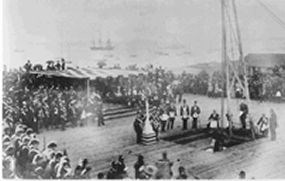
The 1880 act reiterated the earlier resolution and stipulated that as much as $100,000 could be expended under the direction of the Secretary of War "in erecting at Yorktown, in Virginia, the monument referred to in the aforesaid resolution of Congress." In the section of the act that provided for the appointment of a commission "to recommend a suitable design," it was specified that it should contain "emblems of the alliance" between France and America and "a succinct narrative" of Cornwallis' surrender. The design was to be subject to the approval of a committee of thirteen Representatives and thirteen Senators. The artists commissioned for the purpose by the Secretary of War were Mr. R.M. Hunt (Chairman) and Mr. J.Q.A. Ward (Architect) of New York and Mr. Henry Van Brunt (Sculptor) of Boston. The Monument was duly erected, using Hallowell Maine granite in its shaft, according to the design of the commissioned artists who followed the directions relative to emblems, inscriptions and symbols. A first phase had been a model completed in December 1880. Architecturally it was planned and constructed in three parts with a base ('with its stylobate and its pediments"), a sculptured podium (in the form of a drum), and a column. The whole "is intended to convey, in architectural language, the idea, set forth in the dedicatory inscription, that, by the victory at Yorktown, the independence of the United States of America was achieved, or brought to final accomplishment." In design it embodied the symbolic theme originally specified by Congress in 1781 and repeated in 1880. This is described in the official report and can be summarized in the outline as given below: I. The base carries an inscription on each of its four sides: A. One dedicates the monument as a memorial of victory. II. The pediments just over the inscriptions carry: A. Emblems of nationality. "The base is thus devoted to the historical statement." III. The podium is a "symbol of the birth of freedom." It carries the sculptur of thirteen "female figures" hand in hand in a solemn dance to denote the unity of the thirteen colonies. Beneath their feet is the inscription "One country, one constitution, one destiny." IV. The column which springs from the podium, is a "symbol of the greatness and prosperity of the nation after a century of various experience, when thirty-eight free and independent states are shining together in a mighty constellation." There is a star for each state which was in the Union at the time the monument was designed. On the field of the shaft and among the stars, as reminder of the past, is the "shield of Yorktown covering the branch of peace." V. Atop the shaft is the sculptured figure of "Liberty herself" -- attesting to the existence of the nation as "a proof of the possibility of a government of the people, by the people, for the people."
|
Last updated: February 26, 2015
